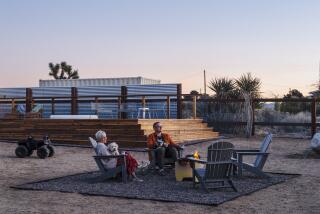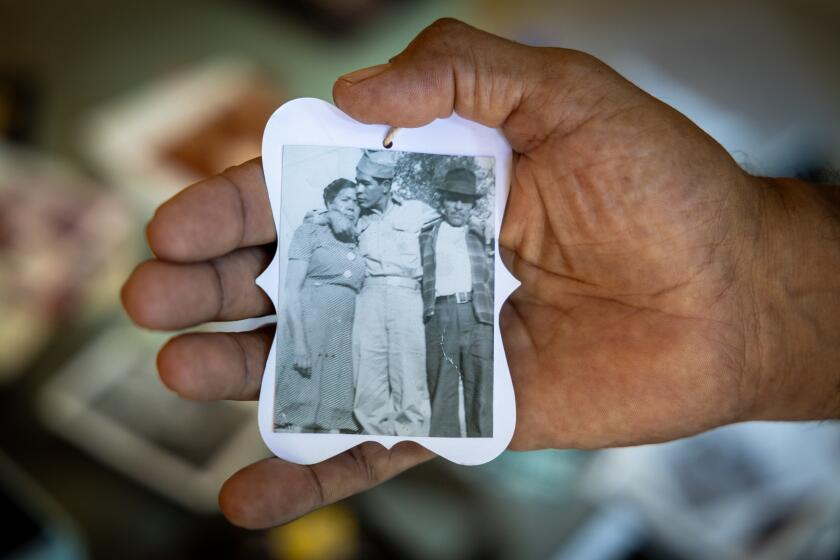House as art, dig?
Josh Agle, the artist popularly known as Shag, doesn’t just draw from life. He paints from his living room. Using the architecture and interior design of his own home, he creates the candy-colored, acrylic-on-Masonite works that have made him an art world double threat — gallery star and hip commercial brand. Populated with groovy ingenues, Rat Pack roués, cute animals, tiki gods and the occasional mythical creature, Shag’s art, which also pops up on stationery and housewares, is an inventory of the furnishings in the 1960 Modernist ranch that Agle decorated for his wife, theater director Glendele Way-Agle and their two children.
Paying a visit is like climbing — Alice-through-the-looking-glass style — into a Shag painting. George Nelson bubble lamps hang by the fireplace, and Eero Saarinen trumpet-based stools sprout near the glass doors leading to a pool surrounded by 1950s yellow fiberglass loungers and faux lava rock Easter Island heads. Arne Jacobsen’s Swan and Egg chairs nest in Agle’s home studio, and two contemporary Scandinavian children’s chairs, for daughter Zoey, 6, and son Zach, 2, flank the Bertoia bikini-pad wire chairs around a Noguchi kitchen table. Circular area rugs in tangy lime and orange dot the rooms.
“Yes,” Agle says, “they are shag carpets.”
“My furniture appears in my work because artists paint what they are surrounded by,” the 42-year-old Southern California native adds. “But it’s also become a part of my vocabulary.”
This vocabulary is a part of the emerging visual language of 21st century Modernism, an aesthetic that embraces contemporary design but constantly looks over its shoulder to the past. You can see it everywhere: in cars like the 2005 Mustang, Target’s new “Design” ad campaigns, and the sets for the animated film “The Incredibles.”
In the work of Shag (the moniker comes from the last two letters of his first name and the first two letters of his last name), the democratization of retro design is visible in the architecture: Space Age penthouses, Palm Springs compounds and ski lodges. The artist’s depiction of these buildings emphasizes the angular lines, steel, glass and stone found in the work of Los Angeles Modernists Richard Neutra and John Lautner and Palm Springs’ William Cody.
Shag compositions often echo what Agle calls the “sparseness” of Julius Shulman’s classic architectural photographs. In these settings, the artist reduces furniture and accessories from the 1950s and ‘60s to simple graphic shapes, arranged with the eye of an interior designer.
“The way Shag uses certain pieces as iconic symbols of modern living definitely inspires people and builds awareness of midcentury design,” says Jeff Perry, proprietor of Futurama, a vintage home store in Los Angeles.
“I am drawn to organic shapes,” Agle says of the furniture, “for what they represent, something a swinger would have had in his really cool pad.”
Despite his black turtleneck, fashionably rectangular eyeglasses and barely noticeable blond goatee, Agle is a suburban dad, not a beatnik with a collection of etchings to show the women in his little black book. “Because of the paintings I do and the lifestyle they depict, people have this preconceived notion of what I’m like and assume that my world must match those paintings. And to an extent it does,” Agle says. “Aesthetically, I’m still a swinger.
“Among our art school friends, we were the weirdos who got married in our early 20s,” says Glendele, Agle’s wife of 13 years, who sports a bob with vibrant blond and red streaks. Now ensconced in a small Orange County enclave called Lemon Heights, they are weirdos still. “He’s the dad who stays home and works,” she explains. “I’m the mom who goes off at night to direct a modern interpretation of ‘Medea’ for an avant-garde theater company.” The two bohemians rhapsodize about their slice of suburbia. “The O.C. can be so generic, but this neighborhood is all custom-built houses on big pieces of land,” says Agle. It took seven months of hunting.“We had so many close calls where we’d see a house and think, ‘This is it!’ and then we’d see the crown moldings and oak woodwork and walk out feeling so depressed.”
In 2003 they found a 3,200-square-foot house near Santa Ana, built in 1960, that had not been significantly altered. They scraped off the popcorn ceilings, changed the cabinets and counters in the kitchen, hung hourglass-shaped, spun-aluminum light fixtures and had a mason build a stone fireplace surround with three display niches.
Agle did “junior scientific tests on carpet swatches, smearing them with spaghetti and peanut butter to see which was the most kidproof” before settling on an industrial gray tweed. He also had a new couch custom-built to seat the whole family and paired it with a 7-foot vintage tiled coffee table in front of the fireplace. He hung flea market abstracts and metal wall sculptures bought on EBay.
For months, however, Agle could find nothing to fill the niches above the fireplace. In a burst of inspiration, he turned particleboard, glue, string and paint into three birds that have the whimsical look of Danish modern pewter sculptures.
“There’s always a sense of happiness in his work,” says fellow artist Tim Biskup. Along with his innate Scandinavian design sensibility (Agle is of Norwegian stock), Biskup adds, “Disneyland epitomizes the kind of modernism Josh relates to. When you walk into Disneyland, there’s that sense that everything’s going to be OK. That’s what it’s like at Josh’s house.”
Even after the recent rains, the hillside house has enormous curb appeal and a touch of Magic Kingdom whimsy. Topiary cypress and juniper rise in front of jazzy black Mondrian-style fences and railing designed by Agle. The front door, glazed a vivid shade of orange that he spontaneously customized for the painters, sports an address plaque you might find on a Honolulu hotel room. When the door is opened, a wooden tiki mask designed by Shag greets visitors in the two-story entry.
Up a short flight of stairs, past walls decorated with patterned rugs from IKEA, Agle is at work in the Shag studio. Or, at least, he is trying to be. Son Zach, quite the conversationalist though still largely preverbal, is shrieking. Baxter, a skittish rat terrier, is barking. Soon Zoey, a budding ballerina and painter of all things relating to princesses, will be home from school and pirouetting through the halls.
“Sometimes,” admits the artist, who is preparing for a show in Palm Springs that opens Jan. 28 and three L.A. shows this fall, “I have to lock myself in here to get my work done.”
It is anything but a prison. Built over a three-car garage, the studio has southern and western exposures from its terrace and a soaring A-frame ceiling painted orange and black. The color scheme matches a light fixture that Agle assembled from three plastic flea market lanterns. Shag canvases line the perimeter of the room and lean against the white brick fireplace.
On the wall, across from his oversized Herman Miller maple desk designed by George Nelson, is a gallery of inspirational art. There are original jazz magazine illustrations by Gene Deitch, the work of artist friends including a Biskup Japanese monster painting, and Agle’s current favorites, two canvases that depict ventriloquist’s dummies experimenting with sex and drugs.
Though his work has a cartoon quality, there is usually more of a story on a Shag canvas than meets the eye. Ventriloquist dummies in turtlenecks and medallions lounge like wooden Hugh Hefners in a recent canvas titled “Palm Springs After Dark.” Après-ski lodgers wave merrily through a cafe window to a group of skaters heading obliviously to a patch of cracked ice. There is, Agle says, “a lot of subtext to the people and placement of objects in my work. But as Freud says, sometimes a martini glass is just a martini glass.”
Shag’s work, however, is not a nostalgic portal into some golden age that Agle was denied. “I don’t think the world in my paintings ever existed,” Agle says. “There are a lot of anachronisms. You might find Napoleon or Louis XV hanging out in Modernist homes or people in tuxedos and cocktail gowns ostensibly existing in this late-’50s environment but talking on cellphones or watching plasma TVs.”
During the week, Agle sequesters himself from most 21st century communications and media, working in the studio from 9 to 5 and often well beyond. “My job and my hobby are the same thing,” he says with a shrug. In the evenings he will often roll an IKEA table into the living room and paint while the family watches a ridiculously oversized flat-screen TV. “The thing about TVs,” he says philosophically, “is they always look a lot smaller in the store than when you get them home.”
Agle grew up without the usual pop-cultural stimulation. The eldest of nine siblings, Agle was born in 1962 in Sierra Madre and “raised a strict Mormon.” After spending his early childhood in Hawaii, his family moved into a procession of “unexciting tract houses decorated in country-kitchen style, like 98% of America.”
When Agle was in high school, his parents bought a “flat-roofed wood-and-glass box by a Finnish architect” in Utah, but he didn’t really begin to appreciate the high design and kitsch of midcentury Modern until he discovered demon rum and rock music.
“My parents didn’t even have records when I was a kid,” says Agle, “so the lure of the forbidden got a hold of me.”
At 21, Agle and some newly legal chums made pilgrimages to “the last remaining tiki bars in Southern California, like the Tiki Ti on Sunset Boulevard.” Such places drew them in “for the same reason that they appealed to the typical workingman of the early ‘60s,” Agle explains. “You step from the sidewalk into this exotic interpretation of the South Seas. You have these great tropical drinks and if you pay an extra five bucks, you get to keep the tiki mug.” Today, he estimates he has more than 300 such souvenirs, lined up in a glass case in his dining room by an Electrohome hi-fi with a domed plastic lid.
Music played an even larger part in defining Agle’s Modernist aesthetics. While studying architecture and accounting at Cal State Long Beach in the mid-’80s, Agle stumbled onto the L.A. garage music revival led by groups such as Redd Kross and the Unclaimed. The people in that scene, he recalls, “had apartments with 1964 furniture and pictures on their wall, and they listened to 1964 records on a 1964 stereo.”
Impressed by how good a low-budget apartment could look, Agle became an intrepid thrift shopper. One of his first great finds, a high-back bird chair by Harry Bertoia, which Agle had upholstered in purple wool, still occupies a prominent spot in his living room. Then Agle met his future wife, who had come to see him play guitar and sing in a folk punk band called the Swamp Zombies. He also changed his major. “ ‘Starving artist’ is all you hear,” Agle says of his career choice. “But I decided to do what made me happiest, regardless of whether I could make a good living at it.”
He found he could. “It took me eight years to graduate, I was so busy doing commercial illustration,” Agle says. When people asked to buy original pieces, Shag began having shows. To- day his originals sell for $3,500 to $18,000; Whoopi Goldberg and David Arquette are among the Hollywood set who own a Shag. “One of my goals when I started,” Agle says, “is that I wanted my paintings in houses by the best architects. I know I’ve got some [in] Neutras, a John Lautner and a Frank Lloyd Wright.”
Except for an early work, a painterly oil composition of tiki heads in greens and purples, there are no Shags on display chez Agle. Besides being too modest, Agle is more interested in decorating this home with sculpture. In addition to the metal wall reliefs he has collected, he plans to design an outdoor waterfall with bronze statuary.
“I embraced Modernism as a reaction to what I grew up with, traditional Ethan Allen style,” he explains. “Modernism was smart and inexpensive design that stripped away decoration so that even structural elements were lacking in ornamentation. It is a process of simplification where things become so reduced that you can’t go any further.”
Seeing so much of that for such a long time, Agle “began to crave something different. Instead of decorating in the stark Modernist style of 1958, I wanted the warmth of interiors from 1964-66.” It was a time, he says, when people began to integrate ceramics, woven wall hangings and metalwork from the post-World War II California Craft movement into their living spaces.
In small ways, Agle has always practiced that philosophy, and in a much larger way, the things that he has made for his homes are more precious and resonant than his enviable collection of midcentury furnishings. On an atomic-age wood-and-glass side table in his living room, an “I Love Lucy”-era lamp is crowned by a two-tier parchment shade that he handcrafted “when I had more time than money.”
In the kitchen, there’s a mirror framed in a vintage TV with hairpin legs and a rabbit-ears antenna that he made in a college woodworking course. And, over the roaring fireplace, perhaps charting his next flight of fancy, there are the birds. “I would love to cast them in bronze,” Agle says.
His tastes, he says, are changing. “I love the French Empire style,” he says. “My next house, if I had one, would probably be Modernist combined with Greek and Roman elements, like something a 1940s Hollywood starlet would’ve retired in with swag drapes and huge gold tiebacks, the kind of thing that would’ve nauseated Charles Eames.”
David A. Keeps is a frequent contributor to Home. He can be reached at home@latimes.com.
More to Read
Get the Latinx Files newsletter
Stories that capture the multitudes within the American Latinx community.
You may occasionally receive promotional content from the Los Angeles Times.






